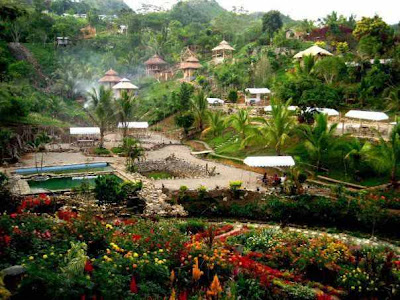I like saying “the
hundred caves of Kulaman.” It sounds like “the hundred islands of Pangasinan.”
I hope the former phrase will be as well known as the latter.
I first heard about
the three-figure caves of Kulaman Plateau in a promotional
video on Sultan Kudarat Province, which I featured in a previous post. At first I thought the
number was an exaggeration.
A hundred
caves in just one town. Are you kidding me? But when I googled more about
caves and read about karst topography, I learned that Kulaman indeed might be
more holey than I knew. Beneath the mostly slash-and-burned land could be a
maze of tunnels formed for thousands of years by acidic water eating into
limestone.
Karst means “an irregular limestone region with sinks, underground streams,
and caverns.” I have not seen any official-looking website describe
Kulaman’s topography as karstic, but an adventurer or so have done so in an
online forum. Judging by what I know of Kulaman firsthand, the description may
be accurate.
The limestone burial
jars that are now in Cebu City were found in the caves in the western part of
Kulaman Plateau. A decade or so ago, world-class caves were discovered in the
hamlet of Lagbasan, and the site has since drawn considerable attention from
the spelunking community. I’ve heard of several more cave sites in the plateau,
but I’ve gone to only one of them, a large-mouthed cave in the village of
Tacupis.
Me and my mum in the mouth of Tacupis Cave, stretching out the wings of hapless bats
I mentioned the cave
in
an essay that was published in the
Philippine
Daily Inquirer. It is quite an accessible cave, only a hundred meters or so
from the road. (The road, though, isn’t so accessible.) It is even likely that
a settlement appeared in the area because of the cave. From the cave’s mouth,
about ten feet high and twenty feet wide, gushes forth a steady stream, which
didn’t dry up even during the worst days of El Niño in the late nineties.
The cave is beside
the farmland my mother and her siblings own, and I went inside it with about
twenty relatives when I was six or seven. I found the cave beautiful, but not
really breathtaking or awesome. The soil near the mouth was muddy, but the sand
deeper inside was smooth. The water was cold and fresh. The stalactites were
huge (to me, then). And hundreds of bats flapped noisily around. They were
closely knit animals, because they huddled together in the ceiling, forming
dark circles here and there.

Me on my uncle’s shoulders, with muddy legs and reaching up a nest of bats
Now a weird thing
happened during that spelunking experience. Before we went to the cave site, my
aunts and uncles talked about the figure of a naked woman sculpted on the wall
of the cave, so I expected to see it. On our way to the cave, two cousins my
age rushed ahead of the party. I followed them but wasn’t able to keep up. When
I reached the front of the cave, the two boys were already inside, but still
near the mouth.
My cousins could not
keep aflame their mitsa, an
improvised lamp made from a rum bottle with a piece of cloth as a wicker and
kerosene as fuel. Nobody brought flashlights because my uncles and aunts
believed engkantos (fairies) living
in the cave would make modern gadgets malfunction and we could be trapped
inside. When the other boys lit up the mitsa one more time, I saw the cave glow
in green light, and I saw the sculpture on the wall. The woman had long hair
and was naked.
The flame of the
lamp petered out again. The next time it was lit, reddish light bathed the cave
and the woman on the wall.
The others arrived
and we all went inside. I didn’t enjoy much the adventure. I was trembling all
the time because everything—the air, the water, the soil—was cold. I was also
scared because a bat might bite me in the neck and the whimsical engkantos
might decide not to let us out of the cave.
Fortunately, the engkantos
didn’t feel like playing tricks on us that time. We got out of the cave alive,
unharmed, no one of us missing, and with live bats as souvenirs. (I brought a
couple of bats to my grandmother’s house in the next village, where my family
spent the next night. I left the teeny-weeny stinky creatures hanging on a
bamboo stick in the kitchen. When I woke up in the morning, they were gone.)
I didn’t tell anyone
about the woman on the wall, thinking everyone else had seen it. More than ten
years later, when I was already seventeen or eighteen, a cousin and I happened
to talk about the cave. He lived on the family farmland, so he was quite
familiar with the cave. When I mentioned the sculpture, he told me I could have
not seen it because some treasure hunters had torn it down a few years before
my visit. I insisted I really saw a woman and told my cousin about the green
and red light. He insisted that there was no longer a woman there. I let the
topic go and wondered, even up to this day, what I really saw.
Hmmm. The mystical
cave of Tacupis? More on caves next week.





